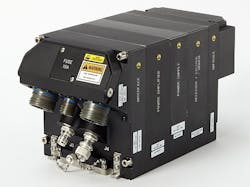Collins Aerospace to provide secure radio communications cryptography for AN/ARC-210 aircraft radios
Officials of the U.S. Naval Air Warfare Center Aircraft Division at Patuxent River Naval Air Station, Md., are asking Collins Aerospace to integrate the company's programmable crypto engine in versions of the company's AN/ARC-210 airborne radios.
Radios involved in this order are the Collins Aerospace AN/ARC-210 RT-1939A(C), RT-1990A(C), and RT-2036(C). United Technologies Corp. acquired Rockwell Collins for $30 billion this year and changed the company's name to Collins Aerospace.
Collins cryptography experts will use Tactical Secure Voice Suite B algorithms to secure the ARC-210 radios. Company military communications experts launched a program in about 2005 to develop the company’s own programmable crypto engine and embed it in products ARC-210. Embedding crypto in the radio saves space and weight, and enables the company either to make more lightweight radios or add capability.
Related: Raytheon to provide NSA Type 1 encryption for Navy Link 22 radio communications networks
Tactical Secure Voice Suite B algorithms are approved by the U.S. National Security Agency (NSA) at Fort Mead, Md. Suite B non-classified crypto algorithms are developed in private industry, not in government. NSA experts verify the effectiveness of these algorithms and certify them for deployed military systems.
The NSA formed the Tactical Secure Voice Working Group in 2008 to ensure that modernized tactical secure voice devices are interoperable across the U.S. Department of Defense (DOD). This group's work led to the Tactical Secure Voice Cryptographic Interoperability Specification (TSVCIS), which became an official NSA document in July 2009.
The TSVCIS consists of two documents -- one classified and the other unclassified -- that define the voice encoding, encryption, framing, synchronization, key management, and other functions for tactical secure voice and data radio communications. Suite B cryptography follows the unclassified document.
NSA allows use of Suite B unclassified industry-developed crypto algorithms for certain kinds of military communications. Suite B algorithms are openly published and understood. Since Suite B crypto algorithms are unclassified, personnel without security clearances can operate equipment using Suite B encryption, which opens up its use to a broad variety of warfighters -- particularly those on the front lines.
Related: Harris receives NSA Type 1 encryption certification for wideband HF manpack radio
Suite B crypto often is appropriate for secret or otherwise sensitive information with a short shelf life—such as a position report on a moving enemy force. In addition to Suite B algorithms, NSA allows Suite A crypto for the military's most secret and sensitive communications. NSA also allows a certifiable crypto approach that layers different security products from different commercial vendors in a “good-enough” approach where appropriate.
Suite A crypto has limited use, layered COTS crypto still is in its infancy, and most of industry’s attention in cryptography and crypto modernization is on Suite B, industry experts say. In the recent past, most U.S. military cryptography involved hard-coded devices that were difficult and costly to upgrade.
On this order Collins Aerospace will do the work in Cedar Rapids, Iowa, and will be finished by January 2022. For more information contact Collins Aerospace online at www.rockwellcollins.com, or the Naval Air Warfare Center Aircraft Division at www.navair.navy.mil/nawcad.
Ready to make a purchase? Search the Military & Aerospace Electronics Buyer's Guide for companies, new products, press releases, and videos

